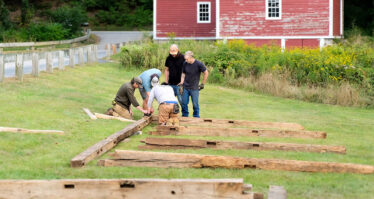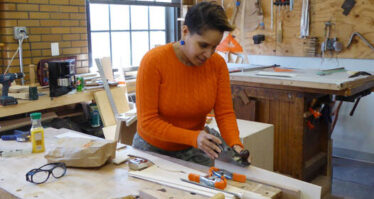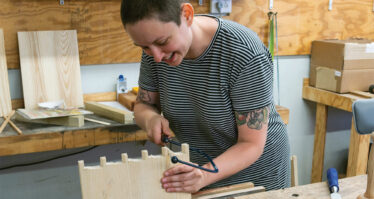Carpentry
Our Carpentry program encourages a commitment to excellence and a mastery of the craft. After graduating from this nine-month program, you’ll have developed the knowledge and skills needed to launch a successful career. Our small class sizes give you plenty of one-on-one time with your instructors, who are experienced carpenters.
In this program, you’ll learn how to construct and renovate residential and commercial buildings. You’ll use hand tools and machines, and learn the different practices of current and emerging industry standards. You’ll experience the importance of working together safely and efficiently on building sites to meet your clients’ needs.
Our Carpentry facilities are well-suited for lectures, benchwork, and small building projects. In addition, you’ll work off-site on construction that may include house additions, garages, or similar projects.
Schedule & Curriculum
We offer rolling admissions and will accept applicants throughout the year. The program is extremely competitive and fills quickly, so you should apply as early as possible. Successful applicants are dependable, have basic math skills, and enjoy physically demanding work and working with others.
- Students are admitted in September.
- The maximum enrollment is 26 students.
- Classes meet 7:30 am – 4:30 pm, Monday – Thursday, September through May.
- The program length is one, nine-month academic year (36 weeks or 1170 class hours*).
- Students are responsible for their own transportation to site work.
- Students who complete the program receive a Diploma of Carpentry.
* Class hours equals clock hours.
Careers
Graduates of our Carpentry program enjoy careers like residential remodeling, contractor work, project management, and many others.
Some of the jobs our graduates have held include:
- Lead carpenter for high-end remodeling and cabinetmaking business
- Finish carpenter for a large contractor
- Job supervisor for high-end renovator/remodeler
- Assistant project manager at a commercial construction company
- Owner of a residential remodeling company
- Carpenter for the State of Massachusetts
Carpenters work throughout the country in almost every community and make up the second largest building trades occupation. Usually, employees with previous classroom training start at a higher level than those without training. Some carpenters change employers each time they finish a project. Others alternate between working for a contractor and working independently.
The DOL classifies Carpenters this way:
Construct, erect, install, or repair structures and fixtures made of wood and comparable materials, such as concrete forms; building frameworks, including partitions, joists, studding, and rafters; and wood stairways, window and door frames, and hardwood floors. May also install cabinets, siding, drywall, and batt or roll insulation. Includes brattice builders who build doors or brattices (ventilation walls or partitions) in underground passageways.
The following information is from the U.S. Department of Labor, Bureau of Labor Statistics:
Carpenters held about 959,000 jobs in 2024.
- 27% of all carpenters were self-employed.
- 23% worked in residential building construction.
- 12% worked in nonresidential building construction.
- 12% worked as finishing contractors.
- 10% worked as foundation, structure, and building exterior contractors.
Employment is expected to increase by 4% during the 2025–35 decade, stimulated by:
- Population growth to meet people’s housing and other basic needs
- Replacing a retiring workforce
- Energy conservation, particularly in the industrial sector
- Home remodeling
- Construction and repair of roads and bridges, financed by the Federal and State governments.
Job opportunities will be good for those with the most training and skills. Carpenters with specialized or all-around skills will have better opportunities than those who can perform only a few simple, routine tasks.
For more information, see the U.S. Department of Labor statistics for Carpentry.
According to Payscale, the median annual salary for carpenters was $53,718 in 2025, with a median hourly rate of $24.88. The Department of Labor (DOL) lists the median annual salary for carpenters as $60,970 or $29.31 hourly in 2023.
The following averages are for specific carpentry-related jobs in 2023:
- Lead Carpenter – Median annual salary: $52,115 | Median hourly wage: $25.01
- Carpenter Foreman – Median annual salary: $58,262 | Median hourly wage: $28.01
- Construction Foreman – Median annual salary: $64,815 | Median hourly wage: $24.96
- Finish Carpenter – Median annual salary: $58,050 | Median hourly wage: $23.79
- Journeyman Carpenter – Median annual salary: $63,104 | Median hourly wage: $30.34
- Assistant Project Manager, Construction – Median annual salary: $62,834 | Median hourly wage: $20.84
- Construction Laborer – Median annual salary: $49,280 | Median hourly wage: $23.69
- Handyman – Median annual salary: $49,326 | Median hourly wage: $24.30
People
Faculty



Meet Our Alumni

Philip Benevides CA ’13“I felt carpentry and the comprehensive and specialized training at NBSS would be a springboard for me to become a master at my new trade.”

Kiemody Crockett CA ’14“I learned so much… about sharpening tools, miters, joints and more. I especially liked working out in the field, solving real problems.”
Explore the Facilities
Our Carpentry facilities are well-suited for lectures, benchwork, and small building projects. There is bench space for each student, a machine room, and flexible space for construction. In addition, students work off-site on construction projects that may include house additions, garages, or similar projects.
Additional Information
- Carpentry program brochure: Download at-a-glance details.
- Admissions Info: How to get your application started and what you need to apply.
- Financial Aid: We’re dedicated to helping you afford the cost of your education. Learn about our financial aid options.
2023 Carpentry Graduate & Employment Report
- 25 Carpentry students started the program in September 2021 and had an intended graduation date of June 2022.
- 96% of this student cohort graduated in 2022.
- 76% of these graduates are employed in the field.
- This data was officially reported to ACCSC in October 2023.
2024 Carpentry Graduate & Employment Report
- 26 Carpentry students started the program in September 2022 and had an intended graduation date of June 2023.
- 88% of this student cohort graduated in 2023.
- 71% of these graduates are employed in the field.
- This data was officially reported to ACCSC in October 2024.
2025 Carpentry Graduate & Employment Report
- 27 Carpentry students started the program in September 2023 and had an intended graduation date of June 2024.
- 100% of this student cohort graduated in 2024.
- 48% of these graduates are employed in the field.
- This data was officially reported to ACCSC in October 2025.
This disclosure is required by our accreditors, the Accrediting Commission of Career Schools & Colleges (ACCSC).
For each of our career training programs, we consult with a group of top professionals in the field to ensure our curriculum continues to meet industry needs and trends.
The Carpentry Program Advisors are:
- Wade Bergeron
- Kate Durrane
- Kurt Fieldhouse CA ’93
- Stephen Gould PC ’01
- Edward Howland
- Arthur Massaro
- Barry A. Mann PC ’97
- Patrick O’Shaughnessy CA ’06
- Anthony Samale
Questions?
Contact Rob O’Dwyer, Director of Admissions, at 617-227-0155 x111 or admissions@nbss.edu.


